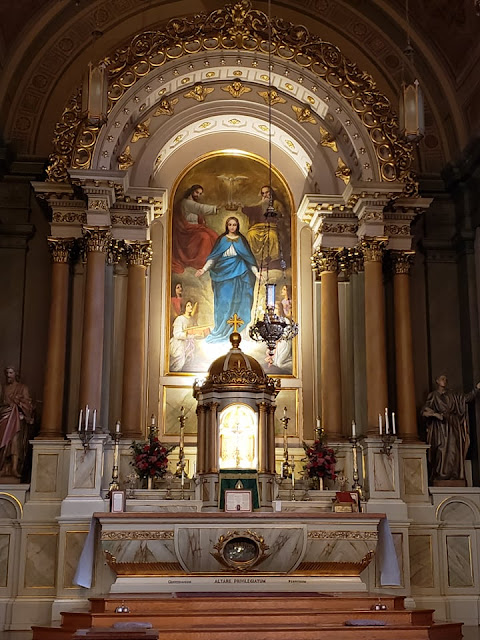Click for the Full Image
As we prepare for another holy season of Lent, I wish to share this chart developed by Tyler Gonzalez showing the changes over time to the Lenten fast. His contributions to this chart and the subsequent annotations were invaluable. I am not aware of any such comparison ever having been created. We would do well to see in this image the great discipline of our forefathers and to rekindle some of these practices this Lent in our fasting.
Key of Terms and Annotated Citations:
A collation is a small repast allowed originally only in the evenings of fast days.
A frustulum is a small repast allowed originally only in the mornings on fast days.
Xerophagiae is a diet of simple, dry, uncooked food, such as raw nuts, bread, fruits and vegetables. Fish and oil are not part of it neither are flesh and animal products. It was a precept to fast on these only during Holy Week by custom and/or decree until the time of Gregory the Great who mentions nothing of it. It may still have been a custom at that time but no mention of it is made in the decretals.
The Passion Fast is a term which refers to the fast which began for some as early as sunset on Holy Thursday and as late as 8am on Good Friday. No one was allowed to eat any food during that time until midnight on Easter Sunday, which since most fasted for Communion extended until morning on Easter Sunday. It was often called a “40hrs Fast” and represents the original Lenten fast. For those who were to weak to follow this fast the minimum fast at this time was that of xerophagiae.
1. Water is not allowed during the day outside of sunset repast. (Butler, Moveable Feasts, Fasts…, 1839, p.155) (C.f. AP. S. Prudentius, hymn, vi, p.188)
2. On the Sunset Repast. (Butler, p.149) (Tertullian, De Jejun, c.x., p.549); (Weiser, Handbook of Christian Feasts and Customs…, 1958, p.170)
3. When the collation was allowed by indult. (Butler, p. 149)
4. When the collation was allowed to the laity. (Butler, p. 152)
5. The original size of the collation. (Butler, p.152)
6. When the collation became ¼ of a meal/8 ounces. It became ¼ of a meal in the 16th century. (Laymann, Theologia Moralis, Lib. IV, Tract. VIII, Ch. I, pp.186-187, 1630)
7. The origin of the frustulum originated around the time of St. Alphonsus Liguori c. 18th century (The Jurist, 1952, p.188) The more common opinion is that St. Alphonsus speaks of electuaries and not a frustulum which were popular in his time. That the origins of the frustulum can be traced to his time is true as a kind of proto-frustulum. However, the greater proof lies in the claim that the frustulum was not explicitly allowed until the end of the 19th century. (Catholic Encyclopedia, Lent)
8. Fish in Lent permitted in its simple “less dainty” form in the 7th Century. The allowance of shellfish permitted around the 10th century (Butler, Moveable Feasts, Fasts…, 1839, p.146)
9. That animal products were not had on days of abstinence. (Weiser, p.170) (Cf. Decretals of Gratian, Letter of Pope St. Gregory the Great to Saint Augustine of Canterbury, 604 AD).
10. That Sundays were days of abstinence. (Thurston, Herbert. « Lent. » The Catholic Encyclopedia. Vol. 9, 1910.)
11. The Passion Fast. (Weiser, Handbook of Christian Feasts and Customs…, 1958, p.201) (Cf. The writings of Saint Irenaeus in 202 AD as quoted in The Church History of Eusebius V 24, 12; PG, 20, 502f)
12. Xerophagiae in Lent. (Butler, p.203-204)
13. On wine in Lent. (Dom Prosper Guéranger, The Liturgical Year: Lent, 1887, p. 5) (Cf. St. Cyril of Jerusalem [Catech. iv])
14. On when liquids other than wine and water allowed. (St. Thomas Aquinas, Summa Theologiae, IIa IIae,qu.cxlvii,art.vi,ad eum.) (Rev. Antoine Villien, « A History of the Commandments of the Church », p. 315). Since liquids do not break the fast the kind of liquid and/or when it can be taken is now a non-matter. This discourse by St. Thomas was the beginning of this radical change which would not become a general custom until around the 15th century when food became allowed at the collation. Until then liquid was strictly speaking only allowed twice a day.
15. When the time of the meal changed to 3pm. (Butler, p.149) (St. Thomas, Summa Theologiae, Second Part of the Second Part, q.147, a.7)
16. When the time of the meal changed to 12pm. (Butler, p.150) (Durandus a S. Porciano, in 4 dist., 15 quaest., 9., art. 7)
17. When the time of the meal became a defunct matter. (CIC/17, c.1252)
18. Not less than a second meal for collation size. (Jone, p. 263) (McHugh and Callan, pp. 3118-3119). As of 1951 the United States Conference of Bishops adopted the relative norm as the law for the US and as such now allows the collation to be more than 8 ounces.
19. The quality of food at the collation-Fish, warm fish, animal products. (Butler, p. 153) (Metropolitan Catholic Almanac and Laity’s Directory, 1839, Baltimore.) (Villien, p. 312)
20. The consumption of both fish and flesh meat at the same meal. (Butler, p.163)
Want to learn more about the history of fasting and abstinence? Check out the Definitive Guide to Catholic Fasting and Abstinence.




